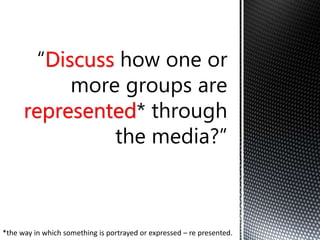
Representations of Youth in Media
- 1. Discuss represented *the way in which something is portrayed or expressed – re presented.
- 2. Quote – Giroux’s theory of how the youth have been put into an empty category as people do not know how to describe them therefore negative and positive representations have been put into one category. This reflects the fears and anxieties of middle class adults. Specify whether your argument is for, against or both i.e. is the representation mostly negative or positive. Egyptian tomb (4000 bc) – young people have no respect for their parents, rude and impatient, no self control. Heslod (8th century bc) – reckless, disrespectful and impatient of restraint. Plato (4th century bc) - disrespect elders, disobey their parents, ignore the law, riot, morals are decaying.
- 3. ‘Rebel without a cause’ - Negative view: Gets drunk, gets involved with the wrong crowd, looks for attention from his parents but goes about it the wrong way. Lack of responsible parent figures – pressure to grow up quicker than he should. - Positive view: Main character handles certain situations better than the adults e.g. when calming his friend down and getting gun from him. Also, has to look after and raise himself due to absence of parents most of the time. Has manners, attends school to educate himself. ‘The Wild One’ - Negative view: No respect for adults or authority. Spend all of their time causing trouble and chaos. E.g. gang terrorise small town, go into the bars and make lots of noise and start trouble, unaware of people around them. - Positive view: Towards the end of the film, main character has slightly changed, hinted in opening narrative.
- 4. Hoodie cinema article: British cinema portrays youth in a very negative way, people assume everyone wearing a hoodie is trying to cause trouble, people automatically assume this is down to a bad upbringing or just ‘evil’ children, associated with gangs, living on estates however they are real people that crave real relationships and love but are stuck with unfortunate situations. Harry brown/adulthood: Both of these films show an extremely negative view of youth. In Harry Brown we see youths have no respect for adults or the elderly at all, hang around the streets causing trouble and intimidating everyone that walks past, make people feel unsafe, carry weapons and do drugs, don’t care about the effect they have on anyone else. In Adulthood we see youths struggling to make important decisions in life as they lack guidance from an older role model – likewise in Harry Brown. Giroux: Theorist states that youth representations have been constructed by adults and we see what they want us to see through the media – negative stereotypes. Gramsci/ Acland: Acland especially states that negative representations of youth help reinforce hegemony as they contradict normal with deviant behaviour, in an attempt to show youth the right way to behave.
- 5. ‘Hoodies or Altar Boys’ 2009 study: 85% of 13-19 year old boys think newspapers give them bad press, 6% think they portrayed them fairly. Most striking findings – nearly a third said they are always or often wary of boys they don’t know, nearly three quarters have changed their behaviour to avoid other teens – most popular reason for wariness (51%) was media stories about teen boys and 40% was based on their own or friends’ bad experiences. Giroux: Theorist states that youth representations have been constructed by adults and we see what they want us to see through the media – negative stereotypes. Gramsci/ Acland: Acland especially states that negative representations of youth help reinforce hegemony as they contradict normal with deviant behaviour, in an attempt to show youth the right way to behave. Cohen: Moral panic – causes adults to panic about all youths becoming like this. Gerbner: Cultivation theory – people begin to believe what they are shown on TV, mostly at face value. People have a misperception of the truth about youths. We are always shown negative examples of youth on TV e.g. EastEnders, waterloo road, hollyoaks, skins etc.
- 6. Sum up argument – Most representations of youth are negative. They reflect the concerns of their middle class producers - attempt at reinforcing hegemony. Positive representations – found only on TV aimed at younger people, not adults. The effect of media representations on young people is – all youth are put into negative category. Future prediction i.e. by using social media, youth will be able to construct their own representations as this will finally give them a chance to voice their opinions without being held back.
